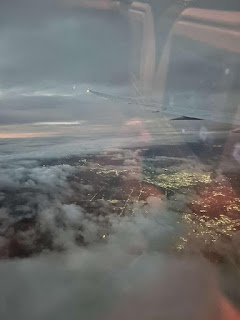Day 10
 |
| Students really enjoyed listening to Mike speak about the efficient methods they use here at Forest Lodge Orchards. |
We started off the day with breakfast at our hotel in Alexandria. We then departed and headed to Forest Lodge Orchard to talk to Mike about electrifying his farm. This is one of the first commercial farms to become entirely free from fossil fuels. Students had the opportunity to learn about electricity on the farms and how it can be used to reduce fuel emissions and save money.
 |
| Cherry trees planted in rows using their pedestrian-walkways. No ladders needed for harvesting, optimizing labor costs. |
We learned a lot from listening to Mike. His cherry orchard is made up of 9,300 trees planted across the 25 kilometers. They supply parts of the northern hemisphere with high-quality export grade cherries. They plant 5 different varieties to reduce their risk. These varieties are made up of Lapin, Sweetheart, Sentennial, Kootenay, and Rainier cherries.
 |
| These are the fruiting buds of the cherry trees. They will first generate flowers and then will grow to the fruit. |
We got to see some of the buds on the tree, and we learned that an egg-shaped bud could produce up to four flowers, which could generate up to four cherries.
Forest Lodge Orchard’s two biggest expenses were labor and
energy. The labor cost is high due to the cherries needing to have the stems
attached. This means they will need to be handpicked. They have adopted parts
of the UFO (upright fruiting offshoots) method which was created at Washington
State. This method was originally created to prevent damage to the trees from
the heavy snows that Washington experiences. This method also allows people to
pick the cherries with no ladders to optimize labor. They can also get more
tress per hectare this way and while they may not be quite as productive, the
extra trees still make up for that.
 |
| The frost fan pulls the warm air down through the cold air pocket into the orchard to warm the temperature. |
To help with energy costs, Mike used his technology systems engineering studies to think up ways to reduce energy. One of the main ways they do this is through an electric frost-fan. The frost-fan pulls the warm air down to the orchard level to warm the temperatures. Most are diesel powered, but Mike has purchased an electric one for his farm, which saves him a lot of money per year on diesel. The next way Mike reduces his energy costs are through the use of an electric tractor. Several students got to enjoy driving the electric tractor. They have built a sprayer that plugs into the tractor, so it is electrically powered as well. This means they can run the sprayer for about 2-2.5 hours before they need to charge it. They have also built their own high-efficiency chargers, so they can charge their tractor up quickly. The other main way that Mike reduces emission usage is using electrically powered golf carts. One is powered with the same batteries as the car, and the other one is powered by lithium-ion batteries. Mike has also installed solar panels on his roof, and has batteries to store excess power for outages so that he is prepared.
 |
|
Students Driving- Students enjoyed driving the electric tractors. |
 |
| The 18 horsepower-equivalent tractor is entirely electric, and it helps to power the sprayer during the day. |
The students enjoyed listening to Mike and learning all about sustainable energy sources within a farm.
 |
|
Fruit Place- Students had the opportunity to buy some fresh fruit and real fruit ice cream at Mrs. Jones’ fruit stand. |
After leaving the orchard, we headed to Queenstown. On our way we stopped at Mrs. Jones’ Fruit Stand for some fresh fruit and ice cream. At Queenstown, students had a lot of leisure time to shop, find food, or walk on paths. They had a great time and enjoyed their time to relax and unwind.
 |
| Queenstown is a gorgeous city surrounded by mountains. |
 |
| Statue of the town’s founder, William, in front of the lake the town was built around. |
After leaving Queenstown, the students boarded the bus for a couple hour ride to the hotel. For dinner they enjoyed a buffet dinner and then had time to get ready for a busy day tomorrow!



Comments
Post a Comment